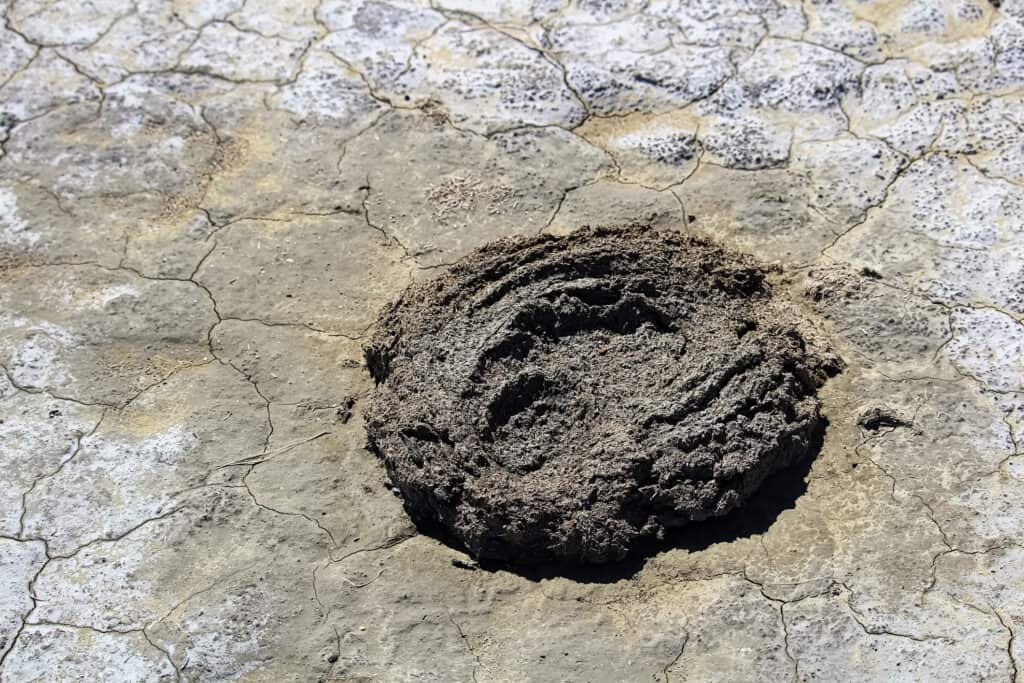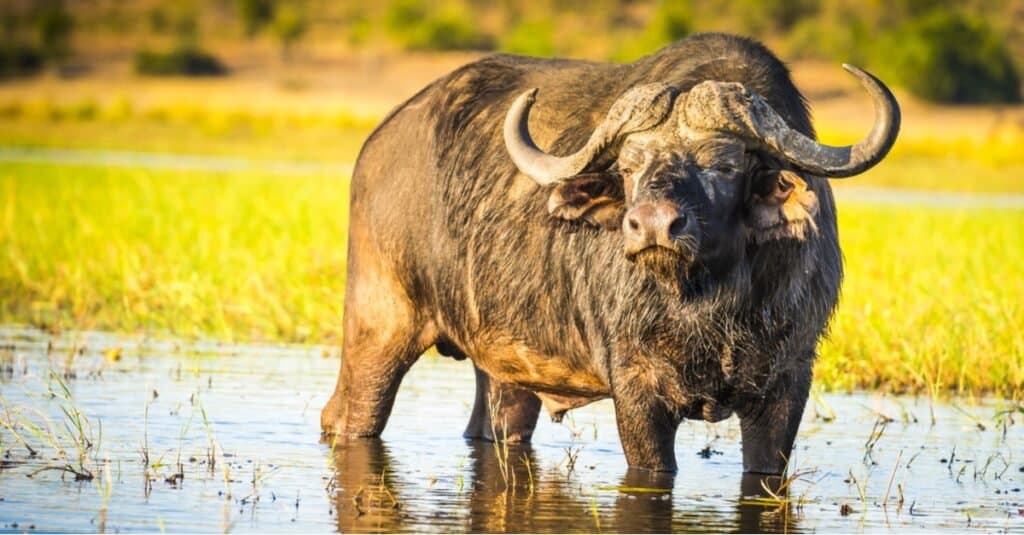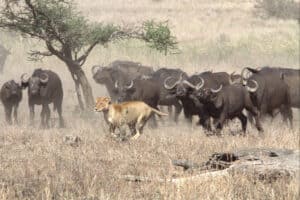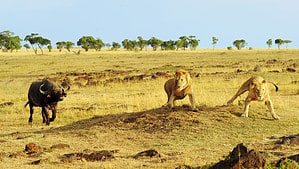Although animal poop doesn’t often make for a pleasant discussion topic, we cannot ignore it, especially when it can be an excellent fertilizer and not only! Today we’ll tell you everything you need to know about buffaloes and their droppings – what they eat, what their poop looks like, and how useful it is! Moreover, since we know many people mistake buffaloes for bison, we’ll help you distinguish between them.
What are buffaloes?

Buffaloes are part of the
Bubalinasubtribe of wild cattle.
©Worchi Zingkhai/Shutterstock.com
Buffaloes are part of the Bubalina subtribe of wild cattle. This subtribe includes three buffalo types: African buffaloes, wild water buffaloes, and anoas.
African buffaloes are scientifically called Syncerus caffer and are the most numerous in the Bubalina subtribe. People have nicknamed these animals “Black Death” because of several deadly attacks on people. Moreover, after a buffalo killed a hunting guide, it became one of the top five most dangerous creatures to hunt.
African buffaloes are large animals, having an average weight of 1,600 pounds and a height of five feet. Moreover, they are excellent runners, as they can reach 35 mph! African buffaloes are of four types:
- Cape buffaloes (Syncerus caffer caffer)
- Forest buffaloes, also called dwarf buffaloes or Congo buffaloes (Syncerus caffer nanus)
- Nile buffaloes (Syncerus caffer aequinoctialis)
- Sudan buffaloes (Syncerus caffer brachyceros)
The second buffalo type in the Bubalina subtribe is the wild water buffalo or the Asian buffalo. These animals have a grayish coat and long, coarse hair. They are native to Southeast Asia and the Indian subcontinent. Asian buffaloes are considered endangered.
Anoas are endemic to Indonesia, to the island of Sulawesi, to be specific. They are a small buffalo species, weighing 330–660 pounds.
These animals are extremely adaptable and can live in any habitat, as long as there’s water nearby. Therefore, buffaloes can be found in swamps, forests, and semi-arid brushlands.
What do buffaloes eat, and what eats them?

Buffaloes eat plants and grass.
©nelik/Shutterstock.com
Buffaloes are herbivorous animals. They eat plants and grass. Like cows, buffaloes chew the grass, spit it out, and then re-chew it. This way, it is easier to absorb the necessary nutrients.
Buffaloes may fall prey to lions and crocodiles. However, humans are considered the biggest threat to the buffalo population.
What does buffalo poop look like?

Buffalo dung is usually light or dark brown but can have shades of green or gray.
©iStock.com/Akchamczuk
Buffaloes poop in large, round piles. Their dung is usually light or dark brown but can have shades of green or gray. They can contain grass. Buffalo poop is often soft.
What is the use of buffalo dung?
Buffalo dung is the subject of numerous studies in regards to its use. Their topics include biogas production from buffalo dung and the involvement of buffalo dung in bio-hydrogen production and methane production, among others.
Scientists conducted a study on buffalo dung bacteria focused on how it could affect the growth of Foeniculum vulgare, a flowering plant species in the carrot family. They showed that four of the 40 so-called “bacterial isolates” taken from buffalo dung were capable of enhancing plant growth.
Therefore, buffalo dung is an excellent fertilizer. Besides this, it also contains beneficial minerals, such as phosphorus, potassium, and nitrogen, that support the growth of soil microorganisms.
Some cultures also use buffalo dung for making paper and insect repellent. Moreover, in India, where approximately 3,400 Asian buffaloes live, people use buffalo poop as a building material. They apply it on their floors and walls to insulate their houses.
Is buffalo manure better than horse manure?

Buffalo dung is an excellent fertilizer.
©THP Creative/Shutterstock.com
When assessing whether a certain manure type is better than another, it’s essential to understand the nutritional values of the two. For example, horse manure has higher nitrogen and potassium levels than cow manure (buffalo implied) and a lower phosphorus level.
So if you’re trying to decide between buffalo manure and horse manure, you can choose either as they’ll have approximately the same benefits on the soil.
Is buffalo poop harmful to humans?
Like other animals’ poop, humans should handle buffalo droppings with great care. Although the risk of getting sick from buffalo poop is low, their dung still contains bacteria and pathogens like Salmonella or Listeria that can cause health issues if ingested. Wearing gloves and disinfecting hands after handling buffalo poop is advisable. You should also keep your pets away from buffalo dung.
As for smelling buffalo manure – it can harm you only if you inhale the vapors of a large quantity of poop in a closed space. While the buffalo poop odor will do you no harm, closed spaces full of buffalo (and other types of) manure, such as underground storage chambers, can kill you. The methane and hydrogen sulfide produced by the manure can be lethal. The most dangerous thing is that they don’t have a smell, and you won’t even notice it. So, the only significant danger buffalo droppings pose consists of you visiting closed spaces packed with manure.
In short, if you’re just handling the manure outside and take all measures of precaution, there’s little to no risk of getting sick.
Buffalo vs. bison: What’s the difference?
Buffaloes are often mistaken for bison, and the other way around. They, indeed, look similar, so we’ve decided to help you with distinguishing them. It’s worth mentioning that we’ve compared bison with the African buffalo species, as they are the most numerous.
First, bison are larger than buffaloes. While buffaloes weigh 1,300–2,000 pounds and are 4–5 feet tall, bison weigh 2,200–2,500 pounds and are 5–6 feet tall.
On the other hand, a buffalo’s horns are much larger than those of a bison, reaching 6 feet horizontally with another 2–3 feet added from the curls. Bison have short, 2-foot-long horns.
Both animals have powerful senses. Bison, for example, have poor eyesight but a powerful sense of hearing and smell. Buffaloes have good eyesight, a sense of smell, and excellent hearing!
Both bison and buffaloes have a top speed of 35 mph.
The photo featured at the top of this post is © PACO COMO/Shutterstock.com
Thank you for reading! Have some feedback for us? Contact the AZ Animals editorial team.






